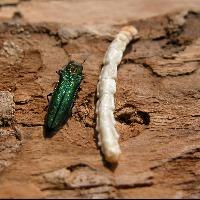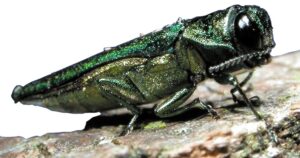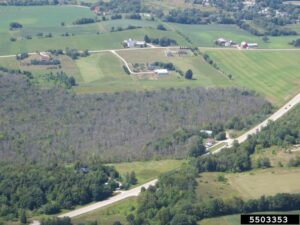EMERALD ASH BORER (Agrilus planipennis)
FOUND IN B.C.? No.
CURRENTLY KNOWN IN: Manitoba, Ontario, Quebec, Nova Scotia, New Brunswick

Photo credit: Alabama Cooperative Extension System
Identification
The emerald ash borer is a wood-boring beetle that is metallic blue-green and bullet shaped. Their body is narrow and long, about 8.5-14 millimetres long and 3.1-3.4 millimetres wide. The prothorax (segment of the body that is closest to the head) is slightly larger than the head and rectangular shaped. Emerald ash borer have short antennae that do not extend past their head. These beetles will not be found on the ground. As larvae, they are 26-32 millimetres long and are a creamy white colour when mature.

Adult emerald ash borer (left) and pupae (right). Photo credit: Invasive Species Centre.
Life Cycle
Eggs of the emerald ash borer are laid in the bark of ash trees. Larvae chew through the side of the egg attached to the tree and bore into and feed on the inner wood. When populations are large enough, larval feeding leads to the eventual death of the host tree. Once inside the tree, the larvae form pupal chambers and overwinter, then pupate in the early spring. When the beetles have fully developed in the late spring, they will exit through the bark of the tree, leaving a D shaped hole. The beetles will feed on the leaves of the tree before flying away to find new host trees. The adult beetle feeds on host tree leaves throughout their life, and the cycle is repeated.

Emerald ash borer damage to an ash tree. Photo credit: Troy Kimoto, Canadian Food Inspection Agency, Bugwood.org
Ecology
Emerald ash borers can be found in areas of agriculture, natural and planted forests, and urban environments with ash trees. These beetles feed on all species of North American ash, including the six species of ash which are native to Canada: green, white, black, blue, pumpkin, and oregon. Blue ash has been found to be the most resistant to the emerald ash borer, but can still be killed by the insect. These beetles are capable of killing up to 99% of ash trees in an area where it invades. There are no natural predators in North America to keep the population of this insect in check. Previously, it was thought that harsh winters killed the beetles, but new research has shown that they are capable of withstanding temperatures as low as -50℃! This means the emerald ash borer can survive very harsh winter conditions in areas where ash trees grow in Canada.

Photo credit: City of Oshawa
Introduction and Spread
This insect is native to China, Japan, North Korea, South Korea, Mongolia, Russia, and Taiwan. It was likely introduced to North America through infested wood packaging materials in the early 1990s. This insect was first detected in Ontario in 2002, and has since spread to 4 other provinces. Once present in an area, these beetles completely devastate ash tree populations within 8-10 years. Adult beetles can spread locally by flying up to 15 kilometres, but their main vector of spread is through the transport of infested wood products. This allows for long distance dispersal of the beetle, as it can hitch a ride at any point in its life stage in wood products.
Impacts
The emerald ash borer is considered one of the world’s worst invasive forest pests, due to the extreme damage it can cause to ash trees. These beetles have already killed over 100 million trees in North America since their introduction, and continue to have huge negative impacts to the forestry industry, the environment, and to human health in urban settings. Industry relies on making a wide variety of goods using ash trees, so the loss of these trees has a major impact on forestry. In forested environments, the loss of ash trees alters species composition and affects forest succession, nutrient cycling, and ecological interactions. Ash trees are commonly planted in cities to provide shade, lower temperature, and improve air quality. In cities where the emerald ash borer is present, replacing these trees becomes a huge economic burden, and human health is impacted by the loss of these services provided by the shade trees. The total estimated economic cost associated with the emerald ash borer is 20 billion dollars!

Overhead visual of emerald ash borer damage. Photo credit: Bill McNee, Wisconsin Dept of Natural Resources, Bugwood.org
What Can We Do?
Check out this podcast to learn about restoration efforts to combat the emerald ash borer.
Or watch our video on Emerald Ash Borer here:
This past year emerald ash borers were spotted west of the Rocky Mountains for the first time. Their spread into BC is unfortunately quite likely, but there are steps we can take to help prevent this and catch their presence early!
- Prevent hitchhikers – inspect goods and vehicles before travelling
- Never move firewood – Buy Local Burn Local
- Report sightings of beetles or beetle activity, such as:
- S shaped galleries in inner tree bark filled with fine wood powder
- D shaped exit holes in tree bark
- Trees that appear to be thinning at the crown, have dead branches and/or yellowing leaves
REPORT: Report all sightings of invasive species to CSISS on our website, to the Province with their online form or on the Report Invasive mobile app.
Literature and Resources:
- https://www.youtube.com/watch?v=uDAmG8lm2U4&t=2s – CSISS invasive insect webinar
- https://natural-resources.canada.ca/our-natural-resources/forests/insects-disturbances/top-forest-insects-and-diseases-canada/emerald-ash-borer/13377
- https://www.sciencedirect.com/science/article/pii/S2666515822000038?via%3Dihub
- https://www.invasivespeciescentre.ca/invasive-species/meet-the-species/invasive-insects/emerald-ash-borer/?gclid=EAIaIQobChMI0fybr5L3-AIVvj2tBh1i1wluEAAYASAAEgIWKPD_BwE